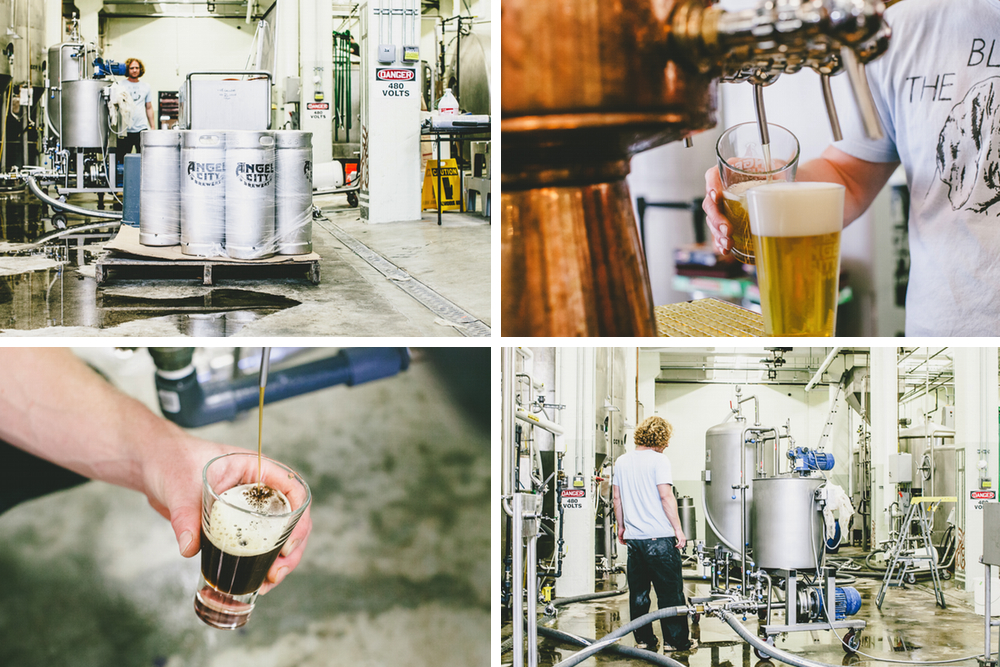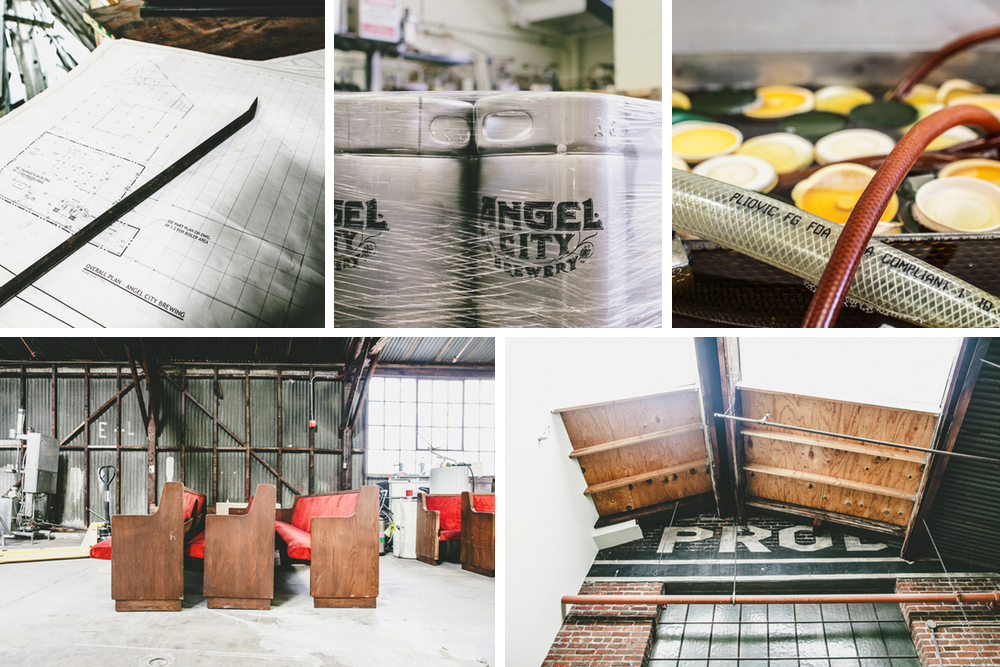For more than 80 years, Los Angeles' claim to brewing fame was the Eastside Brewery. At one time, it was the nation's 5th largest producer of beer, churning out beers like the Eastside Pilsner, Old Mission Malt, and Old Tap Lager. Following Prohibition, the Pabst company bought it in 1948 to expand production of Pabst Blue Ribbon for the west coast, and PBR was produced alongside some of the Eastside brands through the late 70s until Pabst lost its competitive edge.
Forty years later, when we think about the dominant and maturing west coast craft beer industry, many different cities come to mind — San Diego, of course. Portland, Oregon. The rapid growth in brewery start-ups and craft bars in vibrant cities like Seattle and San Francisco. Even small towns dotting the valleys and deserts of California are earning attention. But rarely does anyone mention Los Angeles. This is all about to change. Because right on the northwestern edge of the Artists District, mere blocks from downtown LA, is Angel City Brewing. And as of May 4th, the date of the recently established Heritage Festival, they've been officially open for business. This too is a resurgence of a sort. More than 15 years ago, the Angel City Brewing brand was founded by Michael Bowe in Culver City. But his dream was to have a brewery in downtown LA. Bowe made it as far as the John A. Roeblings building on Alameda and Traction streets, but was never able to drum up the business necessary to sustain the company.
After lying dormant for some time, Alan Newman and the Alchemy & Science division of Boston Beer Co. (the makers of Sam Adams) bought the Angel City brewery — the brand, the building, the brewing equipment — all of it. With many of the traditional Sam Adam's markets flat-lining against newer, more ambitious craft offerings, Boston Beer Co. has been making numerous investments. Sam Adams looks for new markets while the Alchemy & Science team is devoted to continued experimentation both in product and aquisitions. Recently, they brought the Curious Traveller Shandy to market, taking advantage of an explosive trend in sweet, summertime malt liquors alongside Leinenkugel's Summer Shandy and the massive growth of Stiegl Radlers. At the same time, the Alchemy & Science team was working on an acquisition of the Angel City brand, aiming to revitalize the brewery and bring a more traditional craft beer offering to LA. Newman knows a thing or two about how to react to, and lead, a new market. At Magic Hat Brewery, he helped invent Magic Hat No. 9, a beer that neither he, nor the brewing staff particularly enjoyed themselves. But customers wouldn't let them stop brewing it. In his wisdom, Newman understood that No. 9 would enable him and the team to do almost anything they wanted with less risk. For Boston Beer Co., experience like Newman's may prove invaluable as it enters one unprecedented phase of growth after another.
Angel City wasn't a typical acquisition because it wasn't producing at the time. There was no staff, no product, no presence at all. It was largely a clean slate. Newman hired former Gordon Biersch brewmaster, Dieter Foerstner, to help build Angel City Brewing with the mission of bringing great craft beer to the city at large. Rather than try to emulate the kinds of beers that made the west coast famous — big, hoppy IPAs — they're taking more of a cue from LA's past with a German-style Altbier, Berlinerweisse, a wheat beer, and other easily accessible, but sophisticated recipes that will appeal to a mainstream audience in the city. They're not looking for accolades from the craft beer community as much as they're focused on attracting their neighbors and the relatively untapped LA market that will keep them in business and enable them to grow. Foerstner explains, "We're looking at craft beer trends in general, not just LA. IPAs are big. Witbiers are great warm weather beers for the LA climate. They all have our flair. But we have this tasting room so we can find out what LA's tastes are. They can tell us what they like. I'm really hoping they like sessionable beers because those are the beers I really enjoy. Low alcohol content, medium to light body. I love the social aspect of drinking."
Foerstner has been toiling away in the brewery for a little over a year revamping the brewhouse, outlining the plan with Newman, and working on recipes they intend to bring to market right away. With only two beers in distribution on 65-70 accounts around the city, the team would be excited to hit about 8,000 barrels this year, but more realistically, expect to be somewhere between 3-5,000. Foerstner's also been brewing some batches for the taproom that he's happy knowing they'll never bottle. Foerstner has a degree in Hospitality, with a background in food, and tends to approach his recipes with a culinary mindset. His first batch, "Test Batch H" was a juicy, grapefruit-forward pale that was the talk of the town at a beer festival last year. He also tried an avocado beer with 150 lbs of avocados picked from his grandma's ranch, with crushed red pepper, garlic, salt, cilantro, lime peel, "it was basically a guacamole beer," he says, "avocados are so popular here people practically put them on their Cheerios."
Angel City makes many of their decisions by committee, with Newman leading the strategy alongside the sales force, marketing team, and of course Foerstner. "Nobody rules with an iron fist. It's an open discussion. It's a great way to get things done and come up with interesting ideas for different beers," says Foerstner. At Gordon Biersch, Foerstner was told what to make, and how to make it. Coming to Angel City, he was looking for a change. "I knew I was coming here with blank slate. There was no recipe book. It was up to me to get the ball rolling on this and develop recipes and find its beer community."
While a few of their beers are being produced for distribution year-round in the city, the taproom is how they intend to extend a true welcome to their community. Anchored in the front of the brewery, it nestles in among a warren of pillars with art deco ornamentation, ceramic angel statues, and a timber loft style mezzanine overlooking the aging barrels. Part Catholic church, part "Dusk 'Til Dawn" movie set, the scale and detail of the taproom makes a bold impression. "People tend to drag their friends in here," says Foerstner, "so we get all different levels of craft beer drinkers. We soft-launched back in January and we've been open part-time since." While they've already poured at festivals, put some product into market, and opened the doors of the brewery and taproom, Angel City has yet to make their presence fully known. So for the grand opening, or their final stab at a grand opening, they created a festival that might draw in the crowds they're hoping to connect with. "The Heritage Festival is our festival," says Foerstner, "We've had so many false starts at a grand opening that we decided we can't call this our grand opening. We've gotta call it something else. So Alan and Stacey called it the Heritage Festival and it'll be here in the brewery, on the grounds with food trucks and a gospel choir. We have a bunch of old church pews and whatnot. It's quite fitting."
One of the beers served to hesitant converts is the Berlinerweisse with a lime or pomegranate fruit syrup. "We know they're looking for something light, easy drinking, so the Berlinerweiss is for them. We tried the traditional woodruff, an herbal syrup, but we decided not to bring that on. The lime literally tastes like a soda, like a Sprite or a 7-Up. It's a great summertime beer. I've had my fair share of those. I think it'll start catching on." Another beer on tap at the time was a white porter served on nitro. It's almost miraculous getting a heavy roast aroma off a beer that pours more like vanilla ice cream. The cream-colored cloud blooms in the glass, seemingly all head, until it settles out and forms a thick but perfectly palatable body. If there's one beer that represents the angelic side of this brand, this is it.
California's craft beer scene has plenty of room to grow. But many of the established craft brewers like Stone, Firestone Walker, Ballast Point and so many others are already distributing regionally and nationally. For a new brewery like Angel City opening up in a city center, their success is tied to the reception of LA proper. Long before they're able to distribute to the surrounding area with any real credibility, they need to get their neighbors on board and create a passionate following — no small feat in a city that falls far below the national average in craft beer consumption. "Something that differentiates the craft beer industry from a lot of other industries is the community," says Foerstner. "It's the people in your neighborhood and your region. But it's also the other craft brewers working together to build something that's bigger than just our brewery and our brand. It's craft beer. I saw the same thing in Arizona as well. In just the year that I've been away, nine breweries have opened up with more slated to open this year. It's just awesome. We're taking over one palate at a time."
 Michael Kiser
Michael Kiser


























